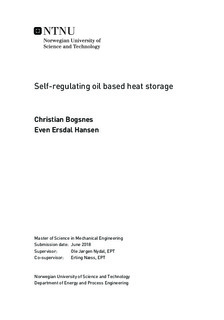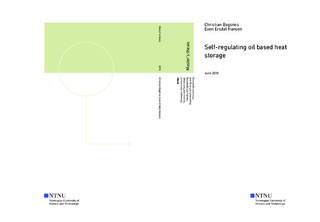| dc.description.abstract | This paper has investigated the possibility of storing excess energy from solar systems as heat, using sunflower oil as the heat storage medium and heat transfer fluid. Three subsystems were designed to heat, store and utilise the hot oil for cooking purposes. The system was primarily aimed for use in developing countries. Also, it was examined if the system could be built locally and if it would be useful. As resources and equipment may be scarce in many of these countries, it was desirable to make the system as simple and robust as possible. This paper covers the subsystems for heating and cooking, while the storage system was covered in a separate paper.
A self-regulating heating system was designed to heat the sunflower oil. It was shown that the heating system could be gravity-driven by utilising the density differences that occur when sunflower oil heated. A requirement for the storage to be successful was that it had to be filled with oil at a constant temperature. This was achieved by maintaining a certain oil level in the heating system. The heated oil was directed into the storage once it had expanded by the desired amount. A custom made fill valve controlled the inlet flow and the oil level in the heating system. The fill valve was designed based on results from previous work.
Two cooking applications intended for frying were designed and produced. The purpose of the first design was to create a simple application that could be produced using basic workshop tools. This criterion was met with an idea of acquiring frying pans of different dimensions and welding them together. Hot oil filled the middle pan, and a smaller one was lowered into it and was used for cooking. A third and larger pan collected the residual oil.
The second application was designed for cooking the traditional Ethiopian flatbread, injera. Therefore, it was inspired by griddles that are commonly used for this purpose. The application was made from aluminium because of its high thermal conductivity. Heat was transferred to the griddle by letting hot sunflower oil flow through a spiral-shaped channel, which was created using a CNC machine. Besides the inlet and the outlet, this application is completely closed, and thus it is safer to use than the other design.
It has been shown that it is possible to create a self-regulating heating system which is simple and robust, purely driven by gravitational forces. Tests showed that the output temperature could be kept within a 15\degree C range for nearly three hours, where the highest temperature was 263\degree C. A field trip to Uganda showed that it was possible to produce this system using local materials and machinery. The cooking applications were only partly successful, but the second design was promising. It was shown that the entire griddle could be kept at a temperature of above 110\degree C for nearly 30 minutes, which is the temperature required to cook injera. The feedback from a local Ethiopian was that the design had great potential. With a few modifications, it would be accepted by local communities and be a useful device. | |

